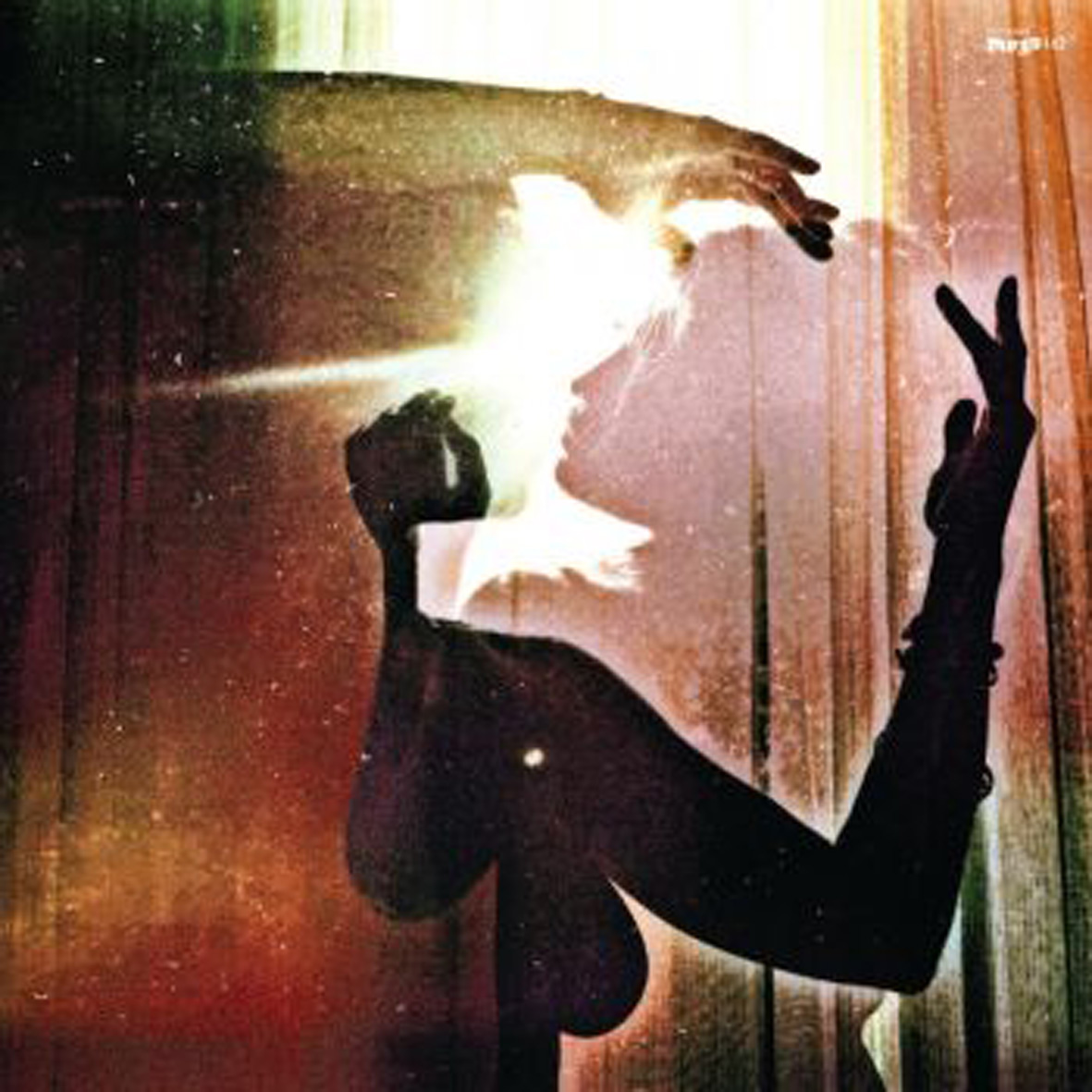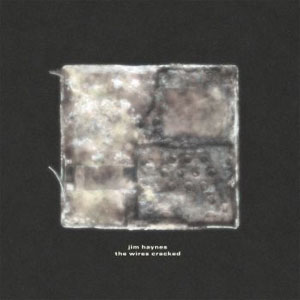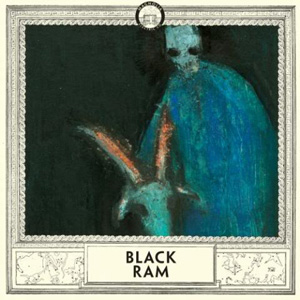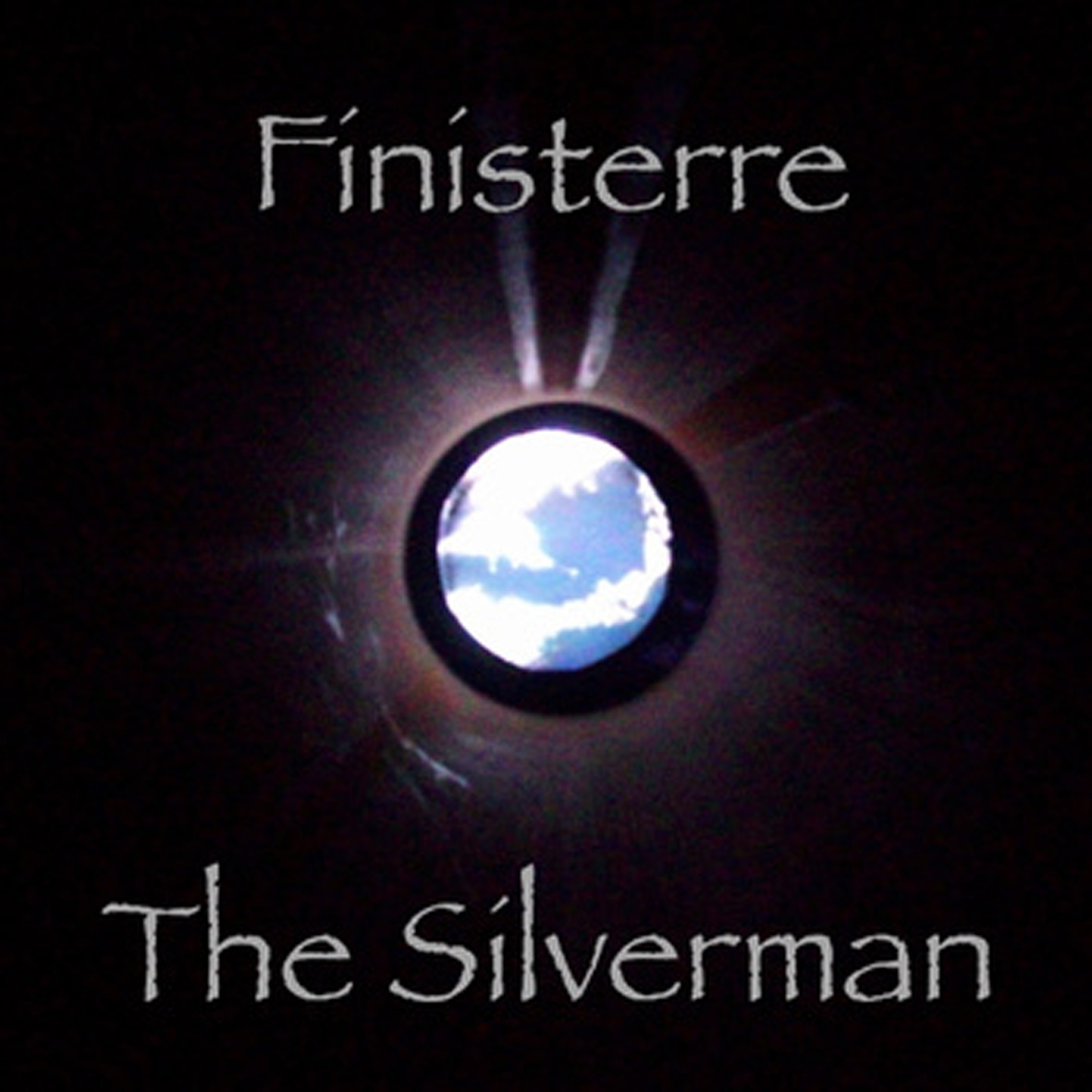- Administrator
- Albums and Singles
 After a 12 year hiatus, Mark van Hoen has unexpectedly returned with a new Locust album.  In fact, I do not think that Mark himself even expected it: he enlisted his friend Louis Sherman to join him for a live performance on WFMU and discovered during their rehearsals that they sounded both 1.) great and 2.) an awful lot like Locust.  As Van Hoen remains the driving force and has a very distinctive aesthetic, the resultant material still shares a lot of common ground with last year's excellent solo album (The Revenant Diary), but You'll Be Safe Forever is floating and melancholic rather than then tense and haunted.
After a 12 year hiatus, Mark van Hoen has unexpectedly returned with a new Locust album.  In fact, I do not think that Mark himself even expected it: he enlisted his friend Louis Sherman to join him for a live performance on WFMU and discovered during their rehearsals that they sounded both 1.) great and 2.) an awful lot like Locust.  As Van Hoen remains the driving force and has a very distinctive aesthetic, the resultant material still shares a lot of common ground with last year's excellent solo album (The Revenant Diary), but You'll Be Safe Forever is floating and melancholic rather than then tense and haunted.
While the return of Locust is certainly a noteworthy event, this is not quite the bold statement that densely paranoid The Revenant Diary was, nor is it meant to be.  Rather, You'll Be Safe Forever seems like a one-off fluke that felt right and deserved to be released.Much of the album's material is based upon both recent improvisations and unused recordings that Van Hoen had from the last half-decade or so.  Despite that, the end result feels like a very coherent album–the only real clue to its somewhat humble origins is that only a handful of songs boast strong hooks.  Thankfully, the less hooky remainder (like "The Washer Woman") sound far more like the soundtrack to an arty, stylized thriller than anything resembling lazy or sub par song-craft.  While he certainly has a quizzical devotion to big, fat '90s-sounding break-beats, I get the impression that Mark is too much of a perfectionist to let anything remotely clumsy, half-baked, or weak see the light of day with his name attached to it.
I definitely prefer the more hook-heavy pieces though.  The album's clear highlight is "Strobes," as Sherman's synth swells are adrenalized by a heavy, relentless groove and Van Hoen conjures up a great hook from a chopped and stuttering female vocal snippet.  The duo never quite manage to get everything so wonderfully right at the same time again, but that does not stop them from producing a handful of other excellent pieces.  For example, the opening "Fall For Me" takes an auto-tuned pop hook and slows it down to a dreamily pulsing, slow-motion haze.  Even better is eerie and subtly hallucinatory "Do Not Fear," in which a sensuous female voice repeatedly urges me to join her while drifting synths cohere into dissonant, sinister harmonies and a slow, heavy groove holds it all together.
For better or worse, that piece exemplifies Van Hoen's recent aesthetic: a precarious balance between booming break-beats and surreal uneasiness.  It seems like an approach that should not work at all, as such beats cannot help but undercut whatever dark, more sophisticated mood the rest of the song seems to be going for.  However, those same unrelenting beats also seem to prevent Mark from ever becoming meandering and indulgent.  When he misses, the result is enjoyable, but mildly perplexing and anachronistic.  When he hits, he somehow makes existential horror and paranoia seem catchy and accessible, which is a neat trick that few others can pull off.  Also, on the rare occasions when the duo dispense with beats entirely ("Corporal Genesis"), the results can be sublimely haunting.
It is telling that the sole significant critique that I can level is also kind of a perverse compliment: Van Hoen seems almost entirely indifferent to all of the dance trends that came and went in Locust's wake.  He is definitely aware of them–he just does not care.  As a result, You'll Be Safe Forever sounds endearingly like a lost classic from the '90s, but one that has been aggressively remastered to make the most of modern recording software.  Some of the more trip-hop/"Portishead" grooves (the shuffling and eerie "Flower Lady," for example) will no doubt make it difficult for this album to connect with as large an audience as it deserves, which I can understand. There is a reason that Mark loves break-beats so much though: they can be very propulsive and satisfying, which provide a perfect counterbalance to his blurrier, more brooding side. The craftsmanship, complexity, and masterfully fractured hooks on display make it well-worth the effort to indulge Locust's quirks.  This is a strong return.
Read More
- Administrator
- Albums and Singles
 Back in 2010, Tarentel's Cantu-Ledesma blindsided me with an absolutely wonderful dream-pop/drone solo opus (Love is a Stream) that I have grown to love more with each passing year.  Since then, however, he has been keeping a curiously low profile, quietly releasing only a handful of tapes, splits, singles, and a Dutch LP.  I wish I had been paying more attention though, as this latest self-released digital EP shows that he has been both creatively fertile and steadily evolving the whole time.  I guess I have some catching up to do.
Back in 2010, Tarentel's Cantu-Ledesma blindsided me with an absolutely wonderful dream-pop/drone solo opus (Love is a Stream) that I have grown to love more with each passing year.  Since then, however, he has been keeping a curiously low profile, quietly releasing only a handful of tapes, splits, singles, and a Dutch LP.  I wish I had been paying more attention though, as this latest self-released digital EP shows that he has been both creatively fertile and steadily evolving the whole time.  I guess I have some catching up to do.
Devotion's aesthetic shares a great deal of common ground with Love is a Stream, as the two releases are both built upon warm oceans of synths and processed guitars.  The difference, however, is that that immersive, blissed-out base is merely the foundation for Devotion, as Jefre rends his beautifully crafted idyll with gnarled blooms of white noise.  In theory, that seems like it would probably be a bad idea, but it proves to be a rather brilliant and inspired one in practice: Cantu-Ledesma's work was already great, now it has even more gravitas, contrast, and distinctiveness.
The secret, naturally, lies in the execution: rather than being jarringly intrusive, Jefre's slashes of stuttering static make his rapturous dreamworld seem deliciously precarious and ephemeral, like catching fleeting snatches of something wonderful on a radio that quickly disappears in a blizzard of interference.  Many artists have released albums of rippling drone nirvana, but Jefre has perfected that formula by making that heaven seem unattainable and viewable only in unpredictable glimpses.
The EP's two strongest pieces are the longer, more layered ones ("The Light Years" and "Roam the Milky Way"), which take very different roads to similar places.  "The Light Years" is built primarily from a warm, slow-moving synth motif that is barely audible amidst the roiling static and chaos that surrounds it, while "Roam the Milky Way" tones down the entropy a bit to allow some angelic female vocal cooing and a descending melody to peak through the omnipresent sizzle and decay.  The remaining two pieces provide a nice dynamic counterbalance, as their simple, repeating chorus-heavy guitar motifs are a fragile oasis that heightens the power of the more dense moments around them.  All four pieces are excellent in their own right, but the heavier drone pieces feel like this release's raison d'être: "Difficult Loves" and "Hand Written Letter" are just well-placed and effective come-downs.
The sole downside to Devotion is that it is far too short to fully drown in, as it only lasts about 20 minutes.  On one hand, that is fine: Cantu-Ledesma has delivered a uniformly wonderful, perfectly sequenced EP with no filler or wrong moves to be found.  On the other hand, this is the kind of music that I want to be completely immersed in, so it is a bit frustrating that it all ends so quickly.  Solely because of that exasperating brevity, I would advise anyone new to Cantu-Ledesma's solo work to seek out Love or Visiting This World first, but Devotion is otherwise both spectacular and essential.
Read More
- Administrator
- Albums and Singles

Artist: Merzbow Vs Nordvargr
Title: Partikel III
Catalogue No: CSR180CD
Barcode: 5060174955372
Format: CD in matt digipak
Genre: Noise / Electronica
Shipping: 23rd May
The third and final part of the Partikel trilogy is finally here! Another beautifully constructed collaboration from the two noise giants – Japanoise King Masami Akita (aka Merzbow) and Swedish Overlord Henrik Nordvargr Björkk (MZ.412, Folkstorm, Toroidh). The styles on ‘Partikel III’ range from total noise barrages, to intelligent electronics, to subtle dark ambient pieces. Essential! Presented in a luxurious matt laminate digipak.
Tracks: 1. Heterotic String Hybrid / 2. Lorentz Covariance / 3. Submaton Color Pt. 1 / 4. Submaton Color Pt. 2)
Read More
- Administrator
- Albums and Singles
Nad Spiro will make a rare live appearance in
London and play tracks from her acclaimed "Atomic Spy" album on Geometrik Records:
Club Integral presents "THE GEOMETRY OF FEAR"
Featuring : Nad Spiro - Static Memories - Cloudier Skies - Ragnaagrok
plus DJ Jules Webbcore and video projections from Rucksack Cinema. £5/£3
Friday 19th April 2013- 8.30 pm
@ The Grosvenor 17 Sydney Road, Stockwell, London
http://clubintegral.wordpress.com/
Read More
- Administrator
- Albums and Singles
 Haynes is a multimedia artist who works in many different mediums and formats, but a consistent sense of rust and decay carries through them all. Recent audio works Sever and The Decline Effect exemplify this perfectly each, built upon layers of found sounds and field recordings, processed and disintegrated into textures and sounds that are enticing, yet alien. For his debut on Editions Mego, he follows the same successful format, using the sounds of desert winds, laser cooling systems, and thin wires as the source, resulting in a work that sounds entirely alien.
Haynes is a multimedia artist who works in many different mediums and formats, but a consistent sense of rust and decay carries through them all. Recent audio works Sever and The Decline Effect exemplify this perfectly each, built upon layers of found sounds and field recordings, processed and disintegrated into textures and sounds that are enticing, yet alien. For his debut on Editions Mego, he follows the same successful format, using the sounds of desert winds, laser cooling systems, and thin wires as the source, resulting in a work that sounds entirely alien.
The first sound that stood out upon the beginning of this album is the harsher, more forceful one captured on "Oscar," melding what could be a dying organ’s tones and violent static outbursts that cut like a knife.These blasts occur erratically throughout, amidst an unsettling bed of crackling walkie-talkie static and ghostly apparitions lurking in the distance.
"X-Ray" Immediately leads off with the hollow, tactile electro-acoustic textures Haynes excels at, adding a metallic rattling and what sounds like a flanged jet engine blast enshrouding it all.For the bulk of its near 14 minute duration though, it stays at a lower level of intensity, like an ambient field recording that cannot be placed in time or space, with clattering dissonance bleeding in to be jarring here and there.
The side-long "November" encompasses both of these sonic extremes, with percussive junk sounds rattling atop disturbing swells and drops in sound.While the cacophony drones away, a low, almost imperceptible melody seems to rise up, eventually everything else is removed to just emphasize this somber tone.Slowly, the noise returns, in a spacious, arid way that closes the piece on the sound of a rusty howl and delicate reverberations, sounding natural yet completely unidentifiable.
The Wires Cracked is a fitting title for this work of decaying metal and erratic electricity.Haynes work has more of a collage, less composed structure, but each segment flows naturally into one another, making for a record that stands up to the fascinating textures and physical worlds of sound that bears his distinct mark. It fits in beautifully next to Sever and The Decline Effect, two of my favorite records of this type of sound art.
samples:
 
Read More
- Administrator
- Albums and Singles
 The always prolific Uwe Schmidt (Senor Coconut, Atom Heart) has produced a third album that continues his push away from the traditional, sterile art of the Raster-Noton label by embracing a skewed, but still engaging take on nostalgic electro pop, bringing in recognizable sign posts throughout while never feeling like an unnecessary throwback.
The always prolific Uwe Schmidt (Senor Coconut, Atom Heart) has produced a third album that continues his push away from the traditional, sterile art of the Raster-Noton label by embracing a skewed, but still engaging take on nostalgic electro pop, bringing in recognizable sign posts throughout while never feeling like an unnecessary throwback.
The most overt and obvious nods are towards Kraftwerk, with the skittering beat fragments and French vocals of the title track implying their later work, and "Stop (Imperialist Pop)," more directly referencing "Musique Non Stop."The latter does veer more towards a cover/parody, but it still works as a stand-alone piece in its own odd way.
"My Generation," featuring contributions from Marc Behrens, sloppily samples bits of the Who song but scatters them amidst a series of intentionally cliché 1980s synth sequences. It manages to maintain the sensibility of the original song but with additions from Schmidt and Behrens that update it for their generation.
The other songs throughout are less specific in their references, but still ooze with nostalgia and familiarity.The live sounding drums and oddly hesitant vocals (courtesy of Jamie Lidell) that pepper "I Love U (Like I Love My Drum Machine)" lead it to some handclap and cowbell heavy perverse approach to synth funk, while "Empty" jumps off with a bouncy electro sense.However the sampled guitars and synthetic percussion that pop up give it a more industrial coloring, albeit a jaunty one.
Classic electro vibes are all over "Strom," with the modern stuttering voice treatments giving a contemporary edge to a breakdance ready song, complete with a pop-lock ready synth hook towards the end.Meanwhile "Ich Bin Meine Maschine,"with Alva Noto, keeps things scaled back with simple, repetitive rhythm loops, showing a more current sheen than the songs that preceded it, eventually pushed over the precipice into full on minimal house beats at the end.
Uwe Schmidt’s work can never be easily predicted, but he does seem to be using the Atom™ guise to inject a bit of pop-oriented levity to the otherwise po-faced Raster-Noton label, but it still manages to fit in amongst their catalog of fragmented rhythms and microsound clicks.Unlike a lot of their releases though, HD exudes a distinct sense of fun, and definitely does not seem to take itself too seriously.
samples:
 
Read More
- Administrator
- Albums and Singles
 Emuul brings patient drone to life with careful repetitions, and succeeds in an attempt to build something acutely iconic on his latest release. Free Structures doesn't drift or wander like a lot of drone music; its very purposeful motifs layer onto one another without reduction in volume and without compromising what is a very singular idea. I found this approach oddly immediate, and welcoming, despite the 17-minute running times of each piece.
Emuul brings patient drone to life with careful repetitions, and succeeds in an attempt to build something acutely iconic on his latest release. Free Structures doesn't drift or wander like a lot of drone music; its very purposeful motifs layer onto one another without reduction in volume and without compromising what is a very singular idea. I found this approach oddly immediate, and welcoming, despite the 17-minute running times of each piece.
I feel like maintaining a single drone—the harmonies and the identity created—is never as easy as it seems. It's very frustrating to try and control the same few notes for upwards of ten minutes without the ideas presented wearing thin. It's even harder when artists like Emuul (Kyle B. Iman) play with small bars of melody and simple loops that repeat endlessly, because a shorter, more staccato piece tends to tire itself out. All the nuances and interactions between notes turn grating when overexposed. It becomes more difficult to endure these small blissful sounds after a point; I feel totally satiated by them and can usually get nothing else out of them. On this album, that is not the case.
Free Structures is an album (very) vaguely themed around the rotation of the Earth (and other metaphors of universal cycles and rhythms), so repetition is an essential aspect to Emuul's approach. The first track, "Waiting For The Letdown," keeps a subsonic tremolo guitar melody sustained throughout the entire 17 minutes. As the song evolves, a few piano chords are dropped in, a harmonic drone in a higher register drifts into focus, and eventually back out, leaving only that initial melody once more. I feel entranced by it, however, not repulsed; its gentle progression suggests an endless meditation on something sublime, and hearing it over and over only serves to reiterate the importance of whatever thoughts cross my mind when I'm listening.
Iman introduces higher tones in the second song, "An Empty Measure," to the ever present guitars and abandons the pulsing motif for a more conventional slow chord landscape common in a lot of drone. Kyle defines the songwith alternately empty spaces and bassy rumbles, like thunder, hitting small peaks and valleys in a more subconscious approach to cycle and form than the other song had. It is the weaker of the two pieces in its indecisiveness, but it still feels intentional, as a companion to the other side; as a complement it plays like Emuul's resolved conscience; whatever grand idea he was wondering about on the first half has been figured out, and I'm just along to hear his reaction to it. It's about as simple as it can be, mining each little moment for whatever vague empathy it can.
Emuul's music pulls me along cautiously, and I feel more informed by the title than the music's own content, which is fuzzy and only suggestive of its wider implications. The music invokes a sure presence; it has a gravity to it that a lot of drone lacks, and an inner logic that holds it together. It's blurry to experience and difficult to unpack. But it invites me to listen again and again, and I find that I enjoy it more each time.
samples:
 
Read More
- Administrator
- Albums and Singles
 This minor but charming solo effort was recorded earlier this year while Ka-Spel enjoyed a vacation on Fire Island.  Given the logistical difficulties inherent in transporting an entire studio across the ocean, these songs are necessarily more loose, informal, and stripped-down than is typical for Edward (if anything about his oeuvre can be described as such).  Such an approach does not necessarily cater to his strengths (Ka-Spel is at his best when he is at his most complexly hallucinatory), but this batch of lilting, drum-machine-driven psych-pop miniatures offers some pleasantly twisted diversions nonetheless.
This minor but charming solo effort was recorded earlier this year while Ka-Spel enjoyed a vacation on Fire Island.  Given the logistical difficulties inherent in transporting an entire studio across the ocean, these songs are necessarily more loose, informal, and stripped-down than is typical for Edward (if anything about his oeuvre can be described as such).  Such an approach does not necessarily cater to his strengths (Ka-Spel is at his best when he is at his most complexly hallucinatory), but this batch of lilting, drum-machine-driven psych-pop miniatures offers some pleasantly twisted diversions nonetheless.
Knowing the origin of this album, it is hard to avoid speculating on both Ka-Spel's mindset and the order in which these songs were composed.  For one, it is amusing to think of anywhere in New York as an appealing vacation option in January.  Secondly, these six songs run the gamut from fragile, melancholy piano balladry ("A Sad Society") to comparatively sunny and upbeat ("One Big Happy Family") to endearingly playful (the strangled blurts of saxophone in "A Step too Far").  Despite that breadth of moods and styles, Fire Island still feels remarkably coherent, which is largely due to its restricted palette (a synth, a saxophone, and a laptop?) and its unexpected accessibility.  The sole exception is the requisite lengthy soundscape filler ("Surfing the Volcano"), but even that avoids becoming particularly nightmarish.
While Fire Island is certainly a refreshing change of pace for Ka-Spel, he was still not able to completely escape some of his more exasperating tendencies (overlong songs, filler, awkward tonal shifts, etc.).  However, with a few exceptions, those quirks are largely kept to a bearable minimum: all of the actual songs are quite good, despite their rough patches.  The most prominent wobbles are the otherwise likable "Mr. Negative" and "One Big Happy Family," which respectively suffer from an awkward string interlude and a vocal crescendo that sounds shrilly elfin, but even those are quite minor.  Most of the other songs are either completely flawless (the warm ambiance of "Entrance and Illumination") or boast motifs strong enough to sustain them through their minor shortcomings (like the heavy groove and peripheral mindfuckery of "A Step Too Far").
Consequently, it is somewhat surprising that this material is relegated to "limited-edition, self-released CDR" status, as it boasts a higher success rate than several of Ka-Spel's more formal, higher profile albums.  There is a certain logic to it, however, as a third of Fire Island's running time is consumed by "Surfing the Volcano" and a one-minute field recording of the sea.  Also, some of the remainder is arguably not particularly representative of Edward's vision (even if he is essentially a human kaleidoscope).  It is quite hard to imagine anyone who is a fan of his work being disappointed by this effort though: it may not be especially revelatory, complex, or ambitious, but it is consistently strong and somewhat unusual (and is almost certainly the leading candidate for "best album ever made on vacation in a beach community in the dead of winter").
Samples:
 
 
 
 
Read More
- Administrator
- Albums and Singles
 In 2005, when Camper Van Beethoven’s gear was stolen on tour, Jason Molina ran into David Lowery and offered to lend him some of Magnolia Electric Co.'s equipment. They became friends and, later that year, met in Richmond, Virginia to record some new songs Jason had in the works. Before he could finish, Molina’s mother suffered a stroke. He completed what he could and returned in 2006 to finish Black Ram, one of the four recordings that finally surfaced as part of 2007’s Sojourner boxed set. Backed by musicians not in the touring Magnolia lineup, it's one of the darkest and most distinct albums Molina ever released—closer to his Songs: Ohia days in spirit and tone, and overflowing with some of his best writing.
In 2005, when Camper Van Beethoven’s gear was stolen on tour, Jason Molina ran into David Lowery and offered to lend him some of Magnolia Electric Co.'s equipment. They became friends and, later that year, met in Richmond, Virginia to record some new songs Jason had in the works. Before he could finish, Molina’s mother suffered a stroke. He completed what he could and returned in 2006 to finish Black Ram, one of the four recordings that finally surfaced as part of 2007’s Sojourner boxed set. Backed by musicians not in the touring Magnolia lineup, it's one of the darkest and most distinct albums Molina ever released—closer to his Songs: Ohia days in spirit and tone, and overflowing with some of his best writing.
Secretly Canadian and Magnolia Electric Co. had a difficult choice to make in 2006. I'm still not sure they made the right one. Jason Molina and company had recorded three albums and two EPs worth of new music in about the span of a year. Faced with so much music, Secretly Canadian inexplicably froze up. Much of what was recorded would appear on the Sojourner box a year later, but at the time they felt they couldn't release everything at once. Instead, they put out a Jason Molina solo record, assembled Fading Trails from songs found on each of the four Sojourner CDs, and quickly followed everything up with a tour.
I still like Fading Trails, but after hearing Black Ram for the first time, I couldn't understand why it wasn't released instead. Had it not been tucked away in an intimidating box set of all new recordings, it might have received the attention it deserves, being one of Molina's best albums. Maybe Jason wanted to focus on the touring Magnolia band instead, or maybe Secretly Canadian planned on releasing Black Ram later. Either way, it half disappeared into the monolith of Sojourner and the fruits of Molina's tireless work ethic. Let Me Go, Let Me Go, Let Me Go kept me occupied for a long time, and before I could absorb everything on Sojourner, Josephine was on the way with the Molina and Johnson record not far behind.
A couple interviews in 2006 hinted at how special Black Ram was to Jason. In a Q&A on the official Magnolia site, he listed it among his best albums, calling it a concept record about a ghost. In a Chicago Reader interview from that same year he referred to it as "high-impact" and strongly emotional. There's no doubt it's a haunted record. That clue about the ghost concept won't solve any of Jason's many lyrical puzzles, but it does clarify his mindset. Lyrically, Black Ram is populated with images of death, dark riders, and an ancient landscape populated by mysterious and dangerous spirits.
It opens with "In the Human World," invoking the "mountains of the dead" and a despair that is better heard than described. It follows with "Black Ram," a song built up from apocalyptic dream images and magic rituals, and from glimpses of ghostly worlds that reside just at the edge of perception. There’s a lot of remembering and yearning, and ruthless self examination that admits guilt and holds on to hope and forgiveness with the same trembling breath—just listen to "What’s Broken Becomes Better" or "Kanawha"; Jason fits it all into tightly written, tersely performed four minute songs that hit as hard as anything on Didn’t It Rain or Magnolia Electric Co.
The subject matter gets so heavy and personal that the album sounds like a journey through the underworld in places, especially on the title track and "Will-o-the-Wisp," two of its most intense songs. Two of Jason's best from Fading Trails—"A Little at a Time" and "The Old Horizon"—are here too, sounding better and more natural alongside their proper brethren, which were all recorded with Miguel Urbiztondo behind the drums and on Harmonium, with David Lowery on bass, and with Alan Weatherhead responsible for guitar, pedal steel, Mellotron, and engineering duties. Filmmaker Rick Alverson, Andrew Bird, and the mysterious Molly Blackbird also lend a hand.
Musically, the band follows Jason’s lyrical lead. The instrumentation shifts from thick and soupy to sparse and skeletal depending on the song, but is always held together by the rhythm section. David Lowery’s bass swells and shakes on every song, providing shades of black and purple color for the guitars to shine against. Miguel Urbiztondo’s drumming pushes the music forward on one or two songs, but otherwise unfolds patiently, not keeping time so much as marking its passing. Even on the more rock oriented material, he keeps things smoky and indistinct, preferring tension and texture to a driving beat. The Mellotron and Harmonium help in that department too. I notice them most when they’re used to create a surface on which the melodies can skate. There is something almost creepy about the sounds the Mellotron makes, as if it were playing back samples from EVP sessions, or broadcasting noise from outer space.
Despite the slow pace and the dark themes, Black Ram uses contrast extremely well, making the darks darker and the light colors that much brighter. Melodically, the album is carried by Jason’s voice and just a few lead instruments. When guitars do take the lead, they do so in a big way. "What’s Broken Becomes Better" has an eviscerating electric solo that cuts so hard it turns the song around, giving it a hopeful finale. "A Little At a Time" also puts a guitar solo front and center, using it to add color and deliver the song’s dramatic climax. But, most of all, I hear and feel the weight of the rhythm section, murky and hot, and the pull of Jason’s singing. When he intones "goodbye, my love / goodbye" on "Will-o-the-Wisp" I can almost see the scene he’s painting; and when "The Old Horizon" finally hits, it chills to the bone—the feeling of isolation and being lost comes on strong, and Jason's use of piano and bowed percussion only amplify that loneliness.
With such strong musical performances, great songs, and such potent lyrical references, Black Ram accumulates a very believable and almost magical atmosphere. Deciphering all the allusions and personal references is probably impossible, but unnecessary anyway. Each time it ends, I leave the album thinking that all the places and spirits Jason mentions are real, that they're not just fanciful representations of personal thoughts, and that I might be able to hear them too if I listen hard enough.
So when the album starts and Jason asks "mountains of the dead are you listening?" I wonder if he is talking to me.
samples:
 
Read More
- Administrator
- Albums and Singles
 This limited-edition CDR is an experiment in spontaneity, as it is the product of a five-day recording frenzy that occurred last winter.  That endeavor proves to be a mixed success, as Taos Hum offers lots of great ideas, but not much in the way of great songs.  That is about what I would expect, as the Dots' Achilles' heel has always been that their voluminous output precludes aggressive editing, a trait that can only be exacerbated by rigid time constraints.  This is still an intermittently impressive effort (the band has definitely been on a hot streak lately), but the best moments are probably too diluted or overlong to offer much appeal to more casual fans.  Which, of course, explains why this is only a CDR.
This limited-edition CDR is an experiment in spontaneity, as it is the product of a five-day recording frenzy that occurred last winter.  That endeavor proves to be a mixed success, as Taos Hum offers lots of great ideas, but not much in the way of great songs.  That is about what I would expect, as the Dots' Achilles' heel has always been that their voluminous output precludes aggressive editing, a trait that can only be exacerbated by rigid time constraints.  This is still an intermittently impressive effort (the band has definitely been on a hot streak lately), but the best moments are probably too diluted or overlong to offer much appeal to more casual fans.  Which, of course, explains why this is only a CDR.
I should know by now that there is no way to predict where Edward Ka-Spel's muse will take him from album to album, but I was still taken aback by the Taos Hum's direction, as LPD's more limited and informal releases tend to be fairly abstract and improvisatory.  This one seems to be neither, as the bulk of these six pieces are coherent, structured songs with lyrics and hooks.  Also, rampant retro-industrial/goth touches make the album feel kind of like a time-capsule from the '80s or '90s (endearingly so, of course).  Such touches are most apparent on the opening "Salem," which is built upon a crunching drum machine beat and lush, minor key synthesizers.  Also, the central sequencer motif in "Divine Resignation" sounds like a close cousin to Severed Heads' "Dead Eyes Opened" (and probably a hundred other songs from that era as well).  Of course, the Dots are far too weird to offer up any such touches in a pedestrian or innocently referential manner. Taos Hum is anything but straight-forward.
Vocally and lyrically, Ka-Spel is in fairly fine form throughout the album, delivering his cryptic words with characteristically simmering intensity.  The songs that work best, unsurprisingly, tend to be the ones with strong hooks, such as the aforementioned "Divine Resignation," but some of the albums' "hooks" can be quite unconventional.  For example, "Ash and Sand" sounds like someone lazily and sloppily playing a banjo over a strangled, ghostly whine, while "The Piper" sounds like it was kitschily (and ingeniously) constructed from one of the preset rhythms on a cheap Casio keyboard.  Naturally, Ka-Spel and company can also sound quite compelling when they plunge into a nightmarishly abstract rabbit hole.  Unfortunately, they often decide to go in both directions within the same song, which is where things get quite dicey.
In fact, almost none of these songs are quite presented in their ideal format and both the album and the individual songs feel uneven and schizophrenic.  This makes Taos Hum feel like a prolonged cavalcade of exasperating misfires.  "The Piper" is probably the best single illustration of the problem, as it starts off as a very catchy and propulsive song that shows hints of fraying at the edges, but then dissolves into fractured free-form abstraction that seems to go on forever.  None of the other songs are quite sabotaged to that extreme, but they all have a maddening tendency to feel about twice as long as they need to be.  Also, the album's longest piece (the closing "Premonition 40") seems like complete filler, sounding like little more than a series of dissonant synth vignettes surrounded by dull dark ambiance.
Despite all of my grievances, I have a nagging suspicion that someone completely new to Legendary Pink Dots would find a lot to like on Taos Hum, as it is brimming with cool ideas and sounds as uniquely surreal and shadowy as anything else in the LPD catalog.  Unfortunately, after having heard so many other Dots' album, I cannot help but expect more from them than this.  That said, the Taos Hum sessions were still kind of a creative success, as the intense, compacted recording session demonstrably inspired a number of very promising, vibrant ideas.  I just wish the band had given themselves enough time afterward to sift through them all and get it right for the actual album.
Samples:
 
 
 
Read More
- Administrator
- Albums and Singles
 One fascinating aspect of the Legendary Pink Dots is that I never know where and when their simmering brilliance will fully manifest itself.  Case in point: this limited-edition solo effort by keyboardist Phil Knight was casually released on CDR on the same day as two other LPD-related albums with only the most cryptic and inscrutable of descriptions ("...aliens here to study mankind had taken control of the airwaves; spread confusion with fake weather reports..."), yet it contains a fluke quasi-noise/industrial collage that ranks among my favorite pieces in the Dots' entire discography.
One fascinating aspect of the Legendary Pink Dots is that I never know where and when their simmering brilliance will fully manifest itself.  Case in point: this limited-edition solo effort by keyboardist Phil Knight was casually released on CDR on the same day as two other LPD-related albums with only the most cryptic and inscrutable of descriptions ("...aliens here to study mankind had taken control of the airwaves; spread confusion with fake weather reports..."), yet it contains a fluke quasi-noise/industrial collage that ranks among my favorite pieces in the Dots' entire discography.
Finisterre consists of a trio of lengthy and very dissimilar soundscapes.  The first, "Fitzroy Cromarty," is the most subtle and drone-like of the three, as it is built upon slow-moving and ominous synth swells beneath a robotic-sounding, ring-modulated voice that seems to be reciting a shipping forecast.  Not much overt evolution occurs over the course of its 19-minute duration, aside from the addition of a faint pulse and a gradual increase in both density and general hauntedness.  That is more than enough to make the piece work though, as its eerie, otherworldly mood is quite wonderful.  To my ears, its masterfully understated dread evokes images of a malfunctioning radio aboard an abandoned boat adrift on a particularly lonely and forgotten stretch of ocean, which is a niche that is all too rarely filled as far as I am concerned.
Unfortunately, the following "Oscar's Last Day" completely ruins the spell for me, as it sounds like an annoying, artificial-sounding bagpipe motif unfolding over a watery, dated-sounding synthesizer bed.  It initially reminded me unfavorably of something that would be playing during a science documentary from the '70s, but then it grew exponentially worse when the mutant Celtic elements start fading in.  While I have thankfully never had a nightmare about a St. Patrick's Day-themed Doctor Who episode, I am dead certain that such a thing would sound an awful lot like this.  I  have absolutely no idea what Knight was trying to accomplish or whether or not he succeeded, but I no doubt that "Oscar's Last Day" is a horrible, horrible piece of music regardless.
Consequently, I could not have been more surprised by the closing "Spring," which is an obsessive, paranoid masterpiece that calls to mind classic Genocide Organ or Maurizio Bianchi.  It starts off with woozy, disorienting swells that mimic the Doppler effect of cars whizzing by someone lying in the road with the life ebbing out of them, as there is an awesomely weird, hallucinatory detachment to the traffic sounds along with some distant, indecipherable shouting.  Somehow, however, the piece gets even better from there, as it gradually snowballs in intensity with menacing hums and an echo-heavy, inscrutable, and layered spoken-word loop that sounds like an ominous news transmission or excerpt from a revolutionary speech.  Then it all slowly fades away without ever making a false move or overstaying its welcome.  It could not possibly be improved.
Such a strong finish makes for a baffling album, as "Spring" is so perfectly sculpted that I fleetingly entertained the possibility that I might be wrong about the execrable "Oscar's Last Day."  After revisiting it, however, my original assessment was brutally reaffirmed: Finisterre consists of an unlistenably bad center book-ended by two truly wonderful and inspired pieces.  As perplexing and aggravating as that is, it still leaves almost 40 minutes of sustained greatness and one piece that I would deem absolutely essential, making the largely under-the-radar Finisterre one of the year's most pleasantly surprising releases to date (albeit one that arguably includes one of the year's worst surprises as well).
 
Read More

